One of the American War’s most intriguing revolutionary vestiges has survived in Đà Nẵng’s historic Ngũ Hành Sơn district.
 Many Đà Nẵng visitors and residents are familiar with the old Nước Mặn helicopter base (21 on the map above), which is situated next to the Đà Nẵng-Hội An road in Ngũ Hành Sơn district.
Many Đà Nẵng visitors and residents are familiar with the old Nước Mặn helicopter base (21 on the map above), which is situated next to the Đà Nẵng-Hội An road in Ngũ Hành Sơn district.
Part of the 1965-built USAF helicopter base has survived, and is currently home to a cement factory, though it retains its runway and several clusters of Hardened Aircraft Shelters.
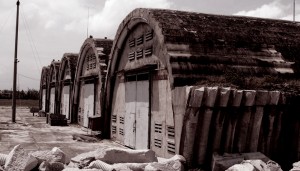
Nước Mặn Airbase pictured in 1968
Some are even aware that the nearby Đà Nẵng Hospital for Women and Children (Bệnh viện Phụ sản Nhi Đà Nẵng) at 402 Lê Văn Hiến, GPS Coordinates 16.022961, 108.249772 (22 on the map above) originated as the NSA Station Hospital, which opened in January 1966 and eventually becme the largest combat casualty hospital in Việt Nam, with nearly 600 beds.
Yet relatively few people seem to be aware of the existence of the former K20 underground resistance base (23 on the map above) which once operated little more than a stone’s throw to the west of it.
This secret base was originally set up by the National Liberation Front (NLF) in 1962 in an area of 4km² beneath the former villages of Đa Phước, Nước Mặn, Mỹ Thị and Bà Đa. The subject of a major display in Đà Nẵng Museum, K20 functioned right down to 1975 and comprised at its height a dense network of up to 157 interconnected secret cellars and tunnels which were used for the storage of weapons and as a base for NLF commando units. They were also the staging point for devastating attacks on Nước Mặn USAF Helicopter Base in October 1965 and January 1968.
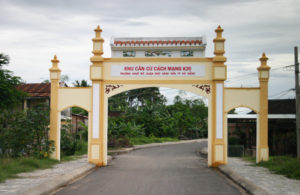
Main gate of K20 Resistance Base in tổ 5, khối Đa Mặn 1, phường Khuê Mỹ
Most of the secret tunnels have long since disappeared and much of the area (situated immediately west of the Đà Nẵng Women and Children’s Hospital) now resembles a large building site. However, a few surviving houses in the riverside area of what is now Đa Mặn 1 village still retain their secret tunnels, and in 2010 these were collectively recognised as a provincial monument.
You may start your visit at the K20 Traditional House (Nhà truyền thống K20) (A on the map above) , GPS Coordinates 16.021549, 108.241992, which opened in 2016. Designed in traditional style with a double yin-yang tiled roof, it is accessed by a three-entrance gateway with four square pillars (trụ biểu).
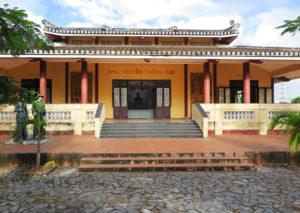
K20 Traditional House (Nhà truyền thống K20) at K20 Resistance Base
The Traditional House houses a large model showing the location of K20 Revolutionary Base, and contains various displays (mostly in Vietnamese) introducing the history of the area from the late French colonial era through to the present day. It recounts the earlier struggle of local people against the French, the construction of the secret cellar and tunnel network starting in 1962, the setting up of the Nước Mặn (Marble Mountain) USAF Helicopter Base in August 1965, and the attacks on the airbase in October 1965 and January 1968.
Displays include a cutaway model of the secret tunnels beneath K20, tools used in their construction, clothing, equipment, weaponry and even a motor bike used by revolutionaries, a diagram showing how the 27 October 1965 attack was carried out, and models of several of the K20 buildings which have secret cellars or tunnels beneath them. The Traditional House also features a map showing NLF operations in relation to US/ARVN bases in Hòa Vang-Đà Nẵng, pictures of Vietnamese government officials and foreign dignitaries who have visited K20, an overview of how the area has developed since 1975, and a display on the “Heroic Mothers” of K20 who lost their sons and daughters to the struggle.

One of the old secret cellars at K20 Resistance Base
Friendly staff members are always happy to conduct visitors on a circular walking tour of the village to see some of the surviving revolutionary vestiges of K20.
Right next to the K20 Traditional House is the Nguyễn Văn Family Temple (Nhà thờ Tộc Nguyễn Văn 阮文祠堂) (B on the map above), GPS Coordinates 16.021350, 108.241761, with its shrine to family patriarch Nguyễn Văn Vinh, who married a local woman and settled here in 1883. Extensively refurbished in 1930 and 1961 and rebuilt in 1994, it was used as an administrative centre during the August Revolution of 1945, and later functioned as a secret revolutionary meeting house and planning centre. Behind the temple is a secret cellar which was used to hide documents, weapons and ammunition.
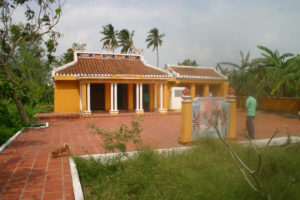
Mrs Nhiều’s Temple at K20 Resistance Base
Continue to the House of Mr Huỳnh Trưng (Nhà ông Huỳnh Trưng) (C on the map above), GPS Coordinates 16.020855, 108.243114, where a secret tunnel built in 1968 remained in constant usage right down to 1975. The stele outside reads: “In this house, Mr Huỳnh Trùng created a secret bunker to hide wounded revolutionary soldiers during the entire period 1968-1975 – Registered Monument.”
The septuagenarian owner of the house, a young cadre at the time of the war, proudly invites visitors into his family temple, opens a secret door beneath the main shrine and leads his guests into a cramped hidden space. With a torch, it’s possible to locate the hole in the floor which was used to access an underground escape passageway leading out to the fields bordering the riverbank.
Your circular tour will bring you next to the Huỳnh Family Temple (Nhà thờ tộc Huỳnh 黄族祠堂) (D on the map above), GPS Coordinates 16.021452, 108.243578, a shrine to the ancestors of the Huỳnh family, which relocated into this area from Huế in 1765.
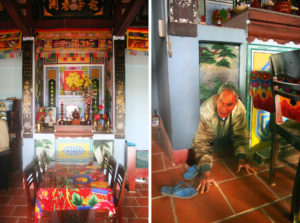
Family temple with secret tunnel in the House of Mr Huỳnh Trưng at K20 Resistance Base
Completely restored in 1994, it was also equipped with a secret storage cellar as early as 1946, and also played an important role as a secret meeting place and training area through two successive wars. It was recognised as a municipal monument in 2005.
A network of tunnels and underground rooms also once existed beneath the recently-restored Mrs Nhiêu Temple (Nhà Thờ bà Nhiêu) (E on the map above), GPS Coordinates 16.021578, 108.242813, outside which a stele reads: “Mrs Nhiêu Temple. She dug six secret tunnels which functioned as the headquarters of the Thành Ủy Đà Nẵng Revolutionary Committee while they directed the revolutionary movement in 1945-1975 – Registered Monument.” Today, the entrance has been bricked up for safety reasons to discourage visitors from descending into what remains of the tunnel network, which is flooded and partially collapsed.
The House of Mr Huỳnh Miên (Nhà ông Huỳnh Miên) (F on the map above), GPS Coordinates 16.021578, 108.242813, on the corner close to the main entrance was also linked to the secret cellar network, though it is not currently open to the public.
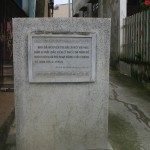
Stele outside the House of Mrs Nguyễn Thị Hải
On your way back to the main road, you may wish to visit one more K20 monument which is located outside the main vestiges area. Head c300m northeast along đường K20, then fork right onto Nguyễn Đình Chiểu street. Around 120m along this street, just after an alley on the left, you’ll see the House of Mrs Nguyễn Thị Hải (Nhà bà Nguyễn Thị Hải) (G on the map above), GPS Coordinates 16.022129, 108.246575,.
The stele outside reads: “The House of Mrs Nguyễn Thị Hải is the place where the first secret tunnels were built in Đa Mặn to hide cadres taking part in revolution from 1962 to 1964. Two interconnected tunnel systems could once be accessed through hatches in the floor beneath a rear building, but the partial collapse of the structure a few years ago left only one small cellar accessible
In a city where many historic structures have already been lost in the headlong rush for modernity, it can only be hoped that other important heritage sites like K20 Resistance Base can be saved for future generations.
Getting there
Khu ăn cứ K20, Phường Khuê Mỹ, Quận Ngũ Hành Sơn, Thành phố Đà Nẵng
Tim Doling is the author of the guidebook Exploring Quảng Nam (Nhà Xuất Bản Thế Giới, Hà Nội, 2020)
A full index of all Tim’s blog articles since November 2013 is now available here.

